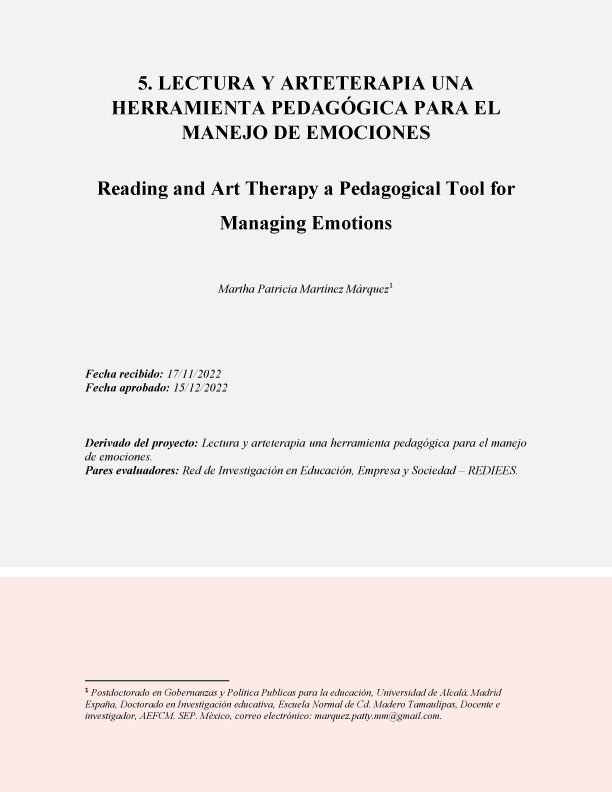V. READING AND ART THERAPY A PEDAGOGICAL TOOL FOR THE MANAGEMENT OF EMOTIONS
##plugins.themes.bootstrap3.article.main##
Abstract
SUMMARY
In Mexico, education, the last level of basic education is Secondary, the stage of adolescence, it is in this grade where the research was carried out. Taking as a background the SARS COVID-19 Pandemic. This research aims to know how, through reading and art therapy, students manage their emotions. To achieve this, a quasi-experimental methodology was used under a Pretest-Postet design with a control group (without treatment) and an Experimental group. (with treatment) Two groups of 30 students each, third grade, are included, the consent of their parents and the school authorities was taken into account. The following were applied: 1. Reading test, 2. Reading habits test and 3. Emotions test, at the beginning of the research and at the end of it, once the treatment was applied. At the end, the following results were achieved: of the participating students in the control group (M33) and experimental group (M31), there are a total of 60 Public Education students. The majority of the M33 group in the first survey of test 1 obtained very low scores with reference to the number of questions, in Test 2. They report that 80% of the young people commented on their dislike of reading, as for Test 3. to the question: Do you find it difficult to express your emotions with words? 36% often mention and 28.8% almost always find it difficult to express their emotions. Finally, the following conclusions were drawn: the students of group M31 showed that the activities on emotion management helped to manage them.
Download Statistics
##plugins.themes.bootstrap3.article.details##
emotions; thoughts; feelings; emotion management; reading; art therapy; pedagogical tool.
Aguilar Sosa, Y. (15 de febrero de 2011). SEP quiere lectores de 20 minutos. La Universal. https://archivo.eluniversal.com.mx/cultura/64805.html
Álvarez-Gayou Jurgenson, J. L. (2006). Cómo hacer investigación cualitativa: fundamentos y metodología. Paidós.
Andere, E. (2021). ¡Aprender! Emociones, inteligencia y creatividad. Siglo XXI.
Sulmont, A. y Martínez, C. (Coord.). (2022). Covid-19 y educación en México: primeras aproximaciones de una desigualdad agudizada. PNUD.
Secretaria de Educación Pública (SEP). (2017). Aprendizajes Claves para la Educación Secundaria.https://www.sep.gob.mx/work/models/sep1/Resource/10933/1/images/Aprendizajes_clave_para_la_educacion_integral.pdf
Boyle, J. (1994). Styles of Ethnography. En J. Morse. (Comp.). Critical Issues in Qualitative Reserch Methods. Sage Publicaciones.
Carrasco Altamirano, A. (2000). Leer, leyendo, lectura. Revista de investigación Educativa, 5(9). 169-171.
Carvallo Ramos Y. (2000). Las necesidades educativas especiales. http://www.educacioninicial.com/ei/contenidos/00/045
Cresswell, J. W. (1998) Qualitative Inquiry and Research Design. Choosing Among Five Traditions. Sage Publications.
Fierro, C., et al. (1995) Más allá de salón de clases, Investigación participativa aplicada al mejoramiento de la práctica docente. Centro de Estudios Educativos.
Márquez, C. (2008). México, en último lugar en índices de lectura de los países de la OCDE. La Jornada http://www.lajornadamichoacan.com.mx/2008/12/23/index.php?section=cultura&article=012n1cul
Mckerman, J. (2001). Investigación en la acción y curriculum. Morata.
Pardo, E. (2004). Leer cuanto y novela. Guía para leer narrativa y dejar que los libros nos hagan felices. Croma Paidós.
Partida, J. C. (2 de diciembre de2009). México se ubica en el penúltimo lugar en el índice medio de lectura entre 108 países. La Jornada. https://www.jornada.com.mx/2009/12/02/cultura/a04n2cul
Petit, M. (1999). Nuevos acercamientos a los jóvenes y la lectura. FCE.
Pérez Gay, R. (29 de agosto de 2010). La lectura, un desastre. El Universal. https://archivo.eluniversal.com.mx/editoriales/49663.html?awesm=fbshare.me_ARwEW
Piglia, R. (2005). El último lector. Anagrama.
Artcoaching. (16 de enero de 2019). Arteterapia. https://www.saludterapia.com/glosario/d/6-arteterapia.html
Sierra Bravo, R. (1999). Tesis Doctorales y trabajos de Investigación científica. Paraninfo.
Samarro Lopez (2004). Escuela para todos. http://www.orienta.org.mx/escuela/
Sastrías, M. (Comp.). (1997). Caminos a la lectura. Pax
SEP (2000). Sexualidad infantil y juvenil. Edición SEP México
Taylor, S. J. (1987). Introducción a los métodos cualitativos de investigación. Paidós.
UNESCO (2021). Las artes y la educación artística. https://es.unesco.org/fieldoffice/santiago/cultura/artes





